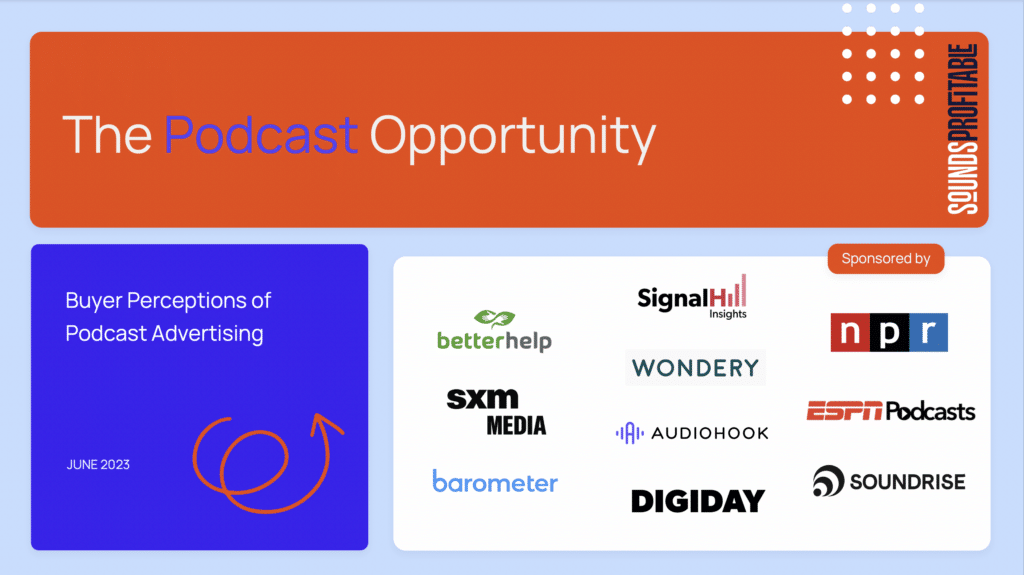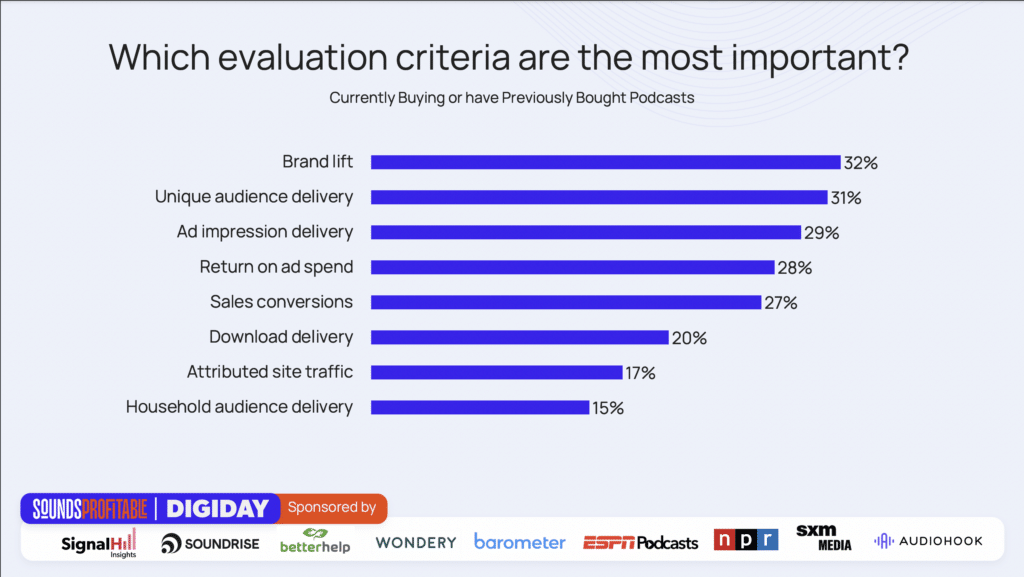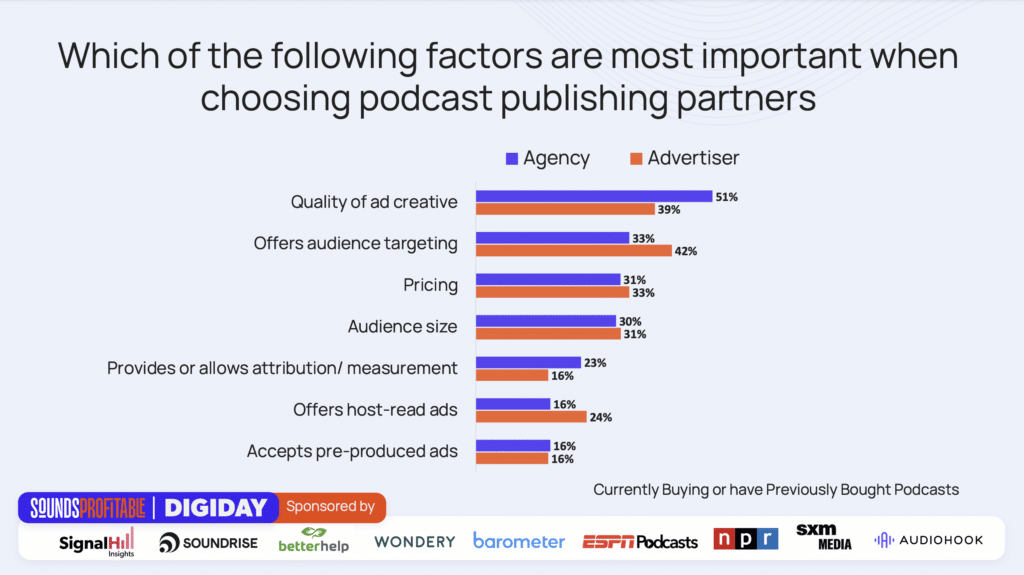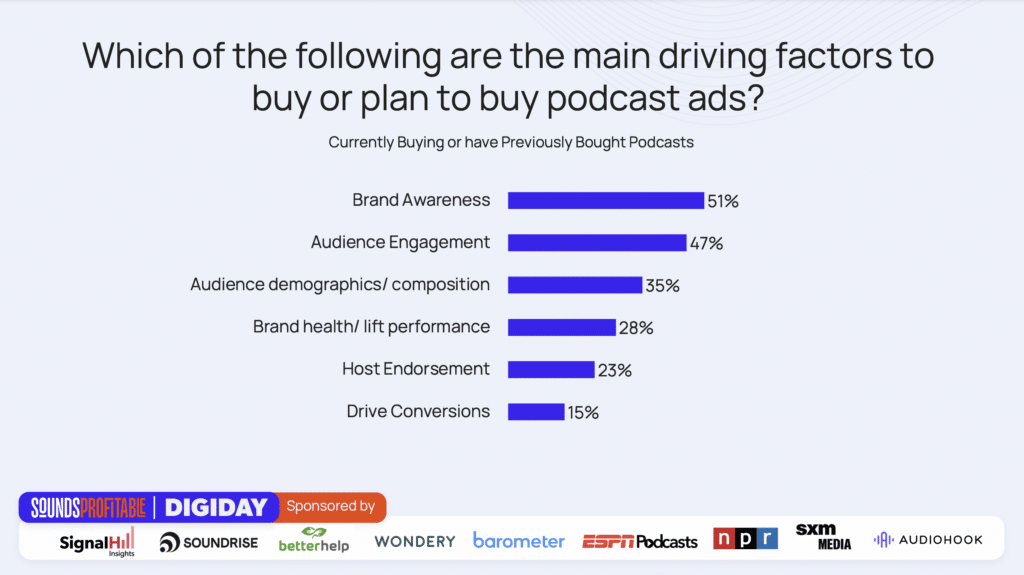Strategies to Enhance Audience Growth through Superior Podcast Production
Longtime listener, first time caller JAR Audio CEO, Roger Nairn, recently sat down with Sounds Profitable partner, Tom Webster, for a quick interview podcast audience growth opportunities for brands about their recent research dubbed, “The Podcast Opportunity.”
The Podcast Opportunity came to be thanks to the combined effort of Sounds Profitable, Digiday, and Signal Hill Insights. The goal? To uncover the thoughts and perceptions of buyers of advertising in podcasts. Over 300 buyers, (brands and agencies) stepped in and offered up their thoughts and feelings surrounding all things podcast ads, from the strengths and weaknesses, to what they think of podcasts as an advertising vehicle in general.
Podcasting is one of the fastest growing advertising mediums in the United States, so they had every right to be curious about how it’s going and what’s held back those who haven’t yet converted.
You’re aware that here at JAR Audio, we don’t do podcast ads. Our goal is to make the podcast itself one big, subtle “ad” for your brand by offering valuable content, chiming in on conversations that establish your brand as a thought leader, and building trust with your audience. BUT: Marketing is as marketing does, so there’s plenty that can be taken from The Podcast Opportunity and applied to our branded podcast opportunities.
I had the delight of listening to Roger and Tom’s conversation so it could be transformed into this post, which is filled with podcast marketing gold.
Their conversation (slightly edited for “terseness”), took place as follows:
___________________________________________________________________________

ROGER: One of the main takeaways from the research that I saw, was the value that advertisers and agencies saw in podcast ads for return on spend. Could you expand on that a bit?
TOM: On one hand, you can look at that as incredibly encouraging in a snapshot view. In another, I think it also points to the fact that so many of the buyers in podcasting — particularly the direct buyers and brand advertisers — are on the direct response side. We’re still not quite even with brand advertising, so it’s a lot of direct response and a lot of performance marketing.
With that weight in the current pool of buyers, it doesn’t surprise me at all that return on ad spend would be so high.
ROGER: On the topic of brand advertising, how do you think brand advertisers then — if they’re not in the direct response space — view podcasts?
TOM: I mean, it runs the gamut. I think there are a lot of savvy agencies -I’ll just throw one out there, not at the expense of any others, but, Horizon Media is now putting together a centre of excellence around podcasting. I’ve done brand lift work for some of their clients, several of whom are just giant national advertisers that carpet bomb every conceivable channel.
And they have gone heavily into it, but they’ve also gone equally heavy into measuring it because that’s what they’re used to. I think podcasting, when the market overall gets bigger, will have more measurement built into campaigns from the start.
For brand advertising in podcasting, just like for almost any other medium, it’s really brand lift survey work. Not everybody’s doing that, but I think those that are definitely see positive results.

ROGER: We saw a lot of positive signs in the report around brand lift and specifically, advertisers and agencies are feeling podcasts are comparable to some of the other streaming services like audio and streaming television. Anything else you can expand on that with?
TOM: Again, I think it really does come down to the environment. First of all, the advertising environment in podcasting — and this is something that came out of our previous study, The Medium Moves the Message — is seen as much less cluttered. People who listen to podcasts perceive the medium as less saturated with advertising as other media that they consume.
And, number two, the people who do listen to podcasts are also more likely to be listening to premium advertising-free services. So you have this group of consumers that listen to podcasts who are both less saturated in their own medium and less inundated in other media with traditional, interrupt, spot advertising.
It’s created this advertising environment that is extraordinarily favourable to get messages across. People are less likely to gloss over them and less likely to be exposed to crushingly long spot loads like you see in commercial broadcast radio. So, part of that is the ad environment in that the ad has less work to do to scrap for attention.

ROGER: What do you think the podcast industry needs to do to get more brands making their own original podcasts? Given the thoughts on podcasts and advertising, what can we do to shore up and get more of them creating their own shows?
TOM: What I suspect is that more case studies with more KPIs that map to what brands are doing in other areas would really help. Even though there are metrics around branded podcasts, a lot of them are forced listening, forced exposure kinds of studies. They’re just not as tactile for a lot of brands as some of the other things they’re looking at.
So, it does require the right kind of brand that has a real story to tell and that people are curious about, in conjunction with folks like you and other branded podcast companies that can create an entertaining podcast around that story. We need more case studies that map to what agencies and buyers already look at as KPIs.
ROGER: How do you get marketers to embrace quality and engagement in production?
TOM: I think you almost have to change two behaviours at once when you’re doing that.
I think producing lower-quality content from a production standpoint is as much a function of a brand that is not quite ready to commit to the medium. It’s, ‘I’m going to experiment at a low cost and see how well it does.’
Well, it’s not going to do great. So it’s almost one of those things where I rather companies not do it at all. Because if you do it at a high quality, you have an enormous chance of succeeding. If you do it at a, ‘we’ve got some airpods and a conference room,’ kind of quality then it’s not going to be great. It’s not going to convince you about the strength of the medium.
In the past in a few different studies, I asked consumers about audio quality andt he one thing I can tell you is that more mass appeal the entertainment vehicle is and the more mainstream the audience for that, the bar for quality goes way up, not way down.
Quality is the path to an audience.

ROGER: I think you just answered the question, but, why do you think more brands aren’t paying to do a podcast well?
TOM: I think it’s important for brands to understand that when you’re doing a podcast, it’s not going to be encountered unless somebody chooses to listen to it over something else. We’re not adding more hours to the day.
What you are competing with, if you’re going to offer me a quality branded podcast that I might be interested in, is not other companies in your category. The competition for that is almost any other spoken word content I could listen to. I could pop in an audiobook. I know that’s going to be high quality.
So, you’re not just competing against your industry competitors. You’re competing for mindshare when the decision to listen to spoken word audio is being made. When you think of it that way, you owe it to yourself to produce the best possible product because quality can be a rate limiting factor to your success.
ROGER: So, the report highlights the lack of introduction and education of the ‘why’ behind podcasts and podcast advertising.
What do you think the podcast industry needs to do to educate the market better?
TOM: Basically, I’ve been coming in for 30 minutes at a time in front of 40 to 50 people on a quick service restaurant team or automotive team at different agencies and being presented as a third party expert to show the results of some of the research we’ve been doing for dozens of agency presentations over the last month.
And people just haven’t seen it. We can show this stuff at podcast conferences all the time, but what we’re really focused on at Sounds Profitable is getting in front of agencies, getting in front of advertising trade organizations in other countries and the broader advertising space so that we’re not just telling the story to ourselves over and over.
So, the education effort can never really stop because every year, you’re going to be talking to new people. We can’t ever assume that we’ve done enough. It’s almost like the Red Queen in Alice and Wonderland — we have to keep running just to stay in one place.
ROGER: When you’re speaking to agencies, are you mostly speaking to quote-unquote, ‘media agencies’ like the OMDs of the world? Are you speaking to strategy creative agencies like the DDBs and Wieden and Kennedys, or is it both?
TOM: It’s kind of both. The podcasting space early on came in sort of through the broadcasting space. Some of the Wieden and Kennedys etc. are among the savviest broadcast buyers in the business who dipped into podcasting very, very early just to learn more of it because they wanted to see how it would fit in with their broadcast buyers clients.
When a broadcast buyer looked at podcasting, especially at that time, you saw something that didn’t quite have the scale, but it gave you options for middle and lower funnel benefits. Now, podcasting is getting trafficked a lot more with digital teams and digital buyers and it has for a number of years.
Ultimately, even though the heart of podcasting to me is an analog medium with fantastic data, for it to be bought and sold at scale it needs to be a digital medium with metrics that match up with what digital buyers expect. And we’ve made a lot of good progress there.
ROGER: The report says there’s a desire for buyers from more creative leadership. What does that look like and what would your recommendation be on what creative leadership should look like?
TOM: For larger podcast networks, I think that means having a creative services division because the more experienced you are with podcasting, the more you know what’s going to work and what’s not in your own content environment.
Ultimately, native-to-podcasting creative is going to outperform repurposed broadcast ads, and somebody has to make them. If you don’t have a centre of excellence or your own podcast-focused creative team as a brand or an agency, then I think the publishers also have to provide some guidance with that. Nobody knows their audience better than the publishers.
There has to be some partnership and some willingness to collaborate on creative, because that’s what’s going to make podcasting perform better, and that’s what I think we all want.
5 KEY Takeaways from the Blog Post
- Understand the Value of Podcast Ads: Podcast ads are highly valued by advertisers for their return on spend, particularly in direct response and performance marketing.
- Brand Advertising Potential: Brand advertisers see positive results in podcasting, especially when measuring brand lift and audience engagement.
- Favorable Advertising Environment: Podcasts offer a less cluttered advertising environment, making it easier for messages to reach and resonate with listeners.
- Need for Quality Production: High-quality production is crucial for the success of branded podcasts. Low-quality production can harm brand perception and audience growth.
- Continuous Education: The podcast industry must continually educate marketers and advertisers about the benefits and opportunities of podcasting to foster greater adoption and investment.
By: Laurissa Cebryk

As the Director of Audience Growth, Liz leads a team of audience growth specialists at JAR, focusing on finding and growing the right audiences for clients. With over a decade of experience in journalism and podcast production, Liz uses data and creativity to create winning strategies. Since joining JAR in 2022, she has integrated audience growth into the production process. Previously, she worked at CBC, Pacific Content, and advised on award-winning podcasts.




